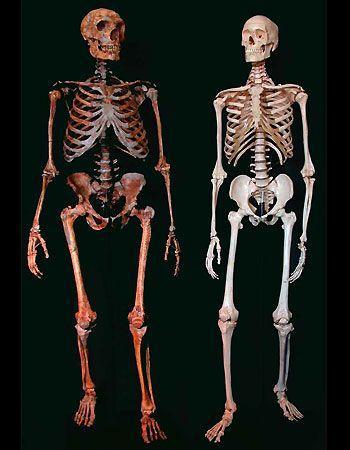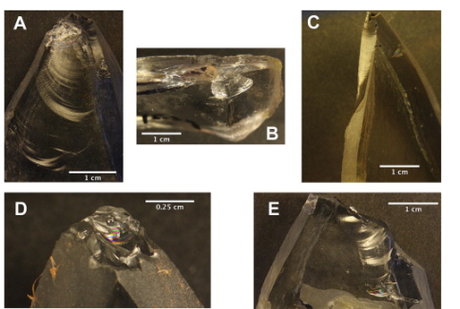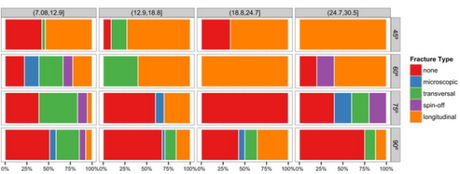Neanderthals were very similar to us; even being so close genetically that we were able to interbreed. But it’s their differences that are fascinating because they suggest that all it takes is a few changes to create something decidedly non-human. A slight change to our brain structure and who knows, we may have never invented the shoe. Being unshod isn’t a particularly strange characteristic, but I think there’s something unnerving about a human with no sole. Badumtsch.

Neanderthal, left, and modern humans
One of the more bizarre differences between us is the fact that many claim Neanderthals couldn’t throw (or at least, not as well as we can). Although this may seem like a fairly minor difference, throwing is very useful. It means you don’t have to get as close to prey to catch them; so less sneaking is required. It also means you can harm them whilst they cannot harm you. As such, having an inferior throwing ability could’ve put Neanderthals at a real disadvantage and help explain why we were taking all their food.
The evidence for this inferior throwing ability comes from 3 sources: anatomical, skeletal and archaeological. Neanderthal anatomy shows their shoulder joint was slightly different, which likely compromised their ability to throw things; skeletal evidence shows that Neanderthals were regularly “thrusting” with spears (rather than throwing them) and archaeological evidence shows that their spears weren’t being thrown.
I’ve talked about the skeletal evidence before, but here is a quick recap. Most suggest that Neanderthals used their spears for up-close-and-personal thrusting rather than long distance throwing because their anatomy would’ve been well suited to that. When you thrust, one arm “guides” the spear whilst the other one puts in all the effort, so if Neanderthals were doing this then they should have evidence of bigger muscles on one side of the body.
For a long time, the data seemed to match this prediction and was hailed as confirming evidence of Neanderthal thrusting (every time I type that word, I giggle). However, there are only a handful of skeletons with both arms present that can be analysed in this manner so it may be that this isn’t representative of the entire population. Further (as I mentioned before) computer simulations of thrusting make different predictions of how the muscles should develop, predictions which don’t match the skeletal data.
The archaeological evidence comes from experimental archaeology, which is when professionals all have a good frolic with ancient technology in the name of science! You simply create a reconstruction of an ancient spear and throw it. Then, you analyze the microscopic damage the spear suffers and compare that to microscopic damage real, prehistoric spears have suffered. If they match up then you know the prehistoric spears were thrown.

Some of the microscopic marks made by throwing a spear at something
Like the skeletal evidence, it was long believed that these experiments had correctly identified the “fingerprint” of throwing and Neanderthal tools lacked it. However, a recent study published in the Journal of Archaeological Science dares to challenge this dogma. They note that many studies into projectile weapons have involved throwing them rarely control for all the variables that may be influencing the type of mark left behind on tools.
The type of material you throw something at, the force the spear hits an object, the shape of the tip, the angle it hits at, the distance it travels, etc. could all influence what kind of microscopic damage the spear suffers. If the “fingerprints” of throwing are actually the result of impacting the target at an odd angle then it might just be that Neanderthals were able to hit their prey dead-on each time.
So these researchers created some machines to do the throwing so that they could control all of these variables, only changing one at a time in an effort to gain a more accurate picture of what was causing the throwing fingerprint. They found that they cropped up most frequently when a spear was thrown at a high velocity and hit the target with an angle of 60 – 70 degrees; or with a low velocity at the same angle. Spears which traveled at a medium speed, or hit the target at a lower/higher angle rarely had the so-called “throwing fingerprint.”

Percentage of spears thrown that had certain microscopic fractures, divided into blocks based on angle (y axis) and speed (x axis). Purple represents the so-called “fingerprint” of throwing.
Some may criticize the study on the grounds that it was laboratory based, whilst research where people actually go hunting and throw spears in the real world produces the fingerprint. However, I think that’s dodging the issue somewhat. The point is that throwing does not produce the specific microwear on these tools, but throwing the spears at a certain velocity and impacting the prey at a certain angle does.
Whilst this paper doesn’t demonstrate that Neanderthals did actually throw spears it undermines one of the key pieces of evidence that they didn’t. Many people I know would continue to argue Neanderthals didn’t throw spears on the grounds that the anatomical evidence alone is strong enough to prove they didn’t. I think they have a point and we’re still a way off over-turning the idea that they didn’t regularly throw spears.
However, I have a sneaking suspicion that it will be overturned one day. First the skeletal evidence for non-throwing is challenged, now this. The pillars which hold up the claim are gradually being toppled and I suspect that eventually the whole house of cards will come crashing down. Then the Neanderthals will be a little bit more human than we thought.
Iovita, R., Schönekeß, H., Gaudzinski-Windheuser, S., & Jäger, F. (2013). Projectile impact fractures and launching mechanisms: results of a controlled ballistic experiment using replica Levallois points. Journal of Archaeological Science.

